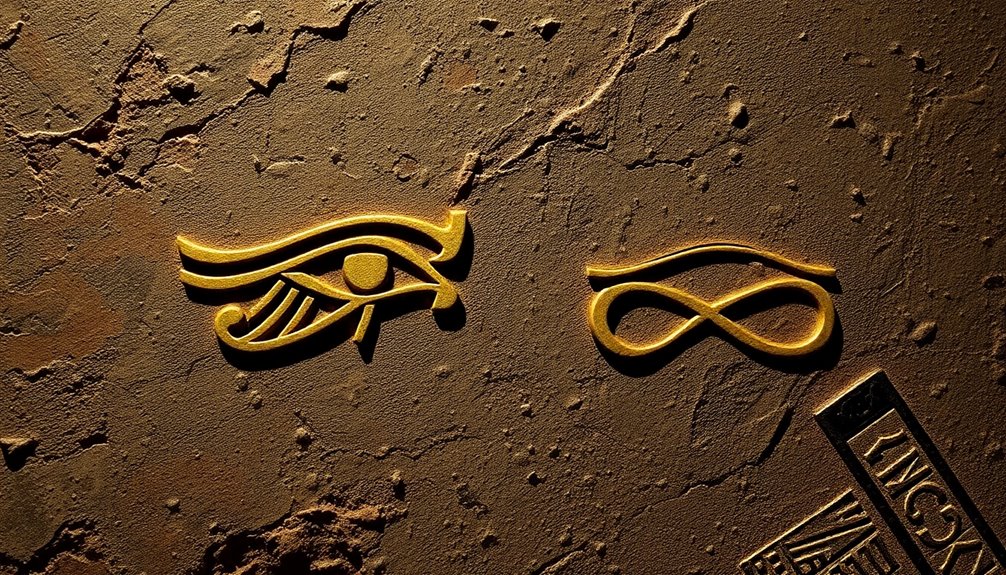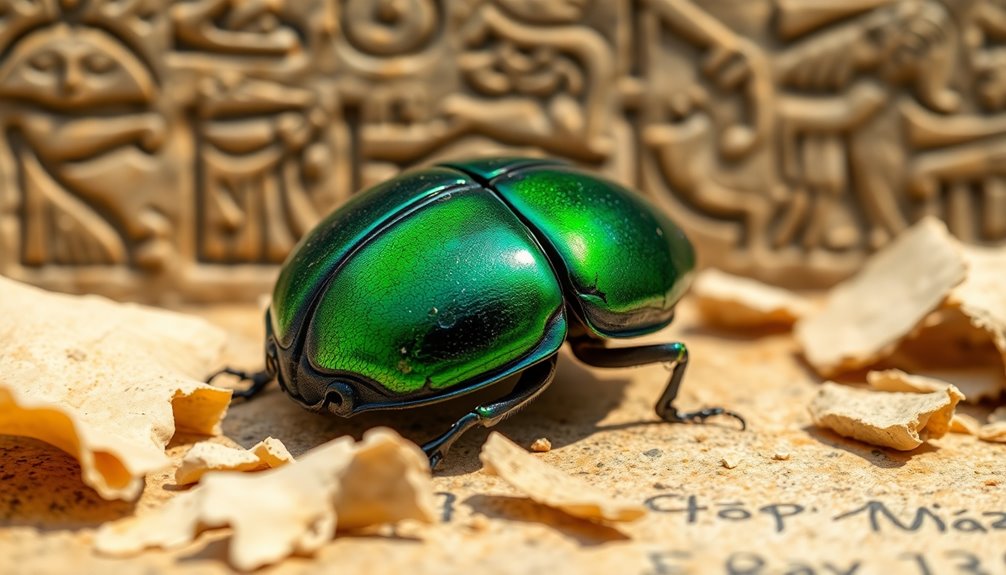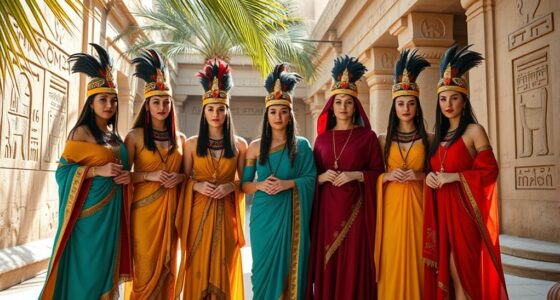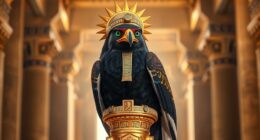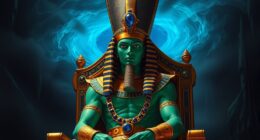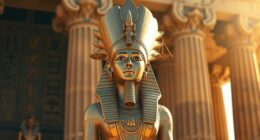The Eye of Horus and the Eye of Ra are enchanting symbols from ancient Egypt, each representing different facets of life and power. The Eye of Horus stands for protection and healing, while the Eye of Ra embodies strength and divine retribution. Their meanings often conflict, sparking debate among scholars. These symbols reflect themes of balance between restoration and dominance. Their influence stretches into modern culture, art, and spirituality, where they still hold significance today. If you're curious about their deeper connections and continued relevance, you'll find there's much more to explore.
Key Takeaways
- The Eye of Horus symbolizes protection and healing, while the Eye of Ra represents power and divine retribution in ancient Egyptian mythology.
- Both symbols have dual meanings, illustrating a balance between power and restoration within cultural narratives.
- The Eye of Horus is associated with fractions in mathematics, symbolizing completeness and balance, while the Eye of Ra links to themes of dominance.
- Contemporary interpretations of both symbols vary, with the Eye of Horus relating to protection and enlightenment, and the Eye of Ra resonating with leadership.
- Ongoing scholarly research continues to uncover deeper meanings, contributing to the debate about their significance in both historical and modern contexts.
Cultural Significance of the Eye of Horus
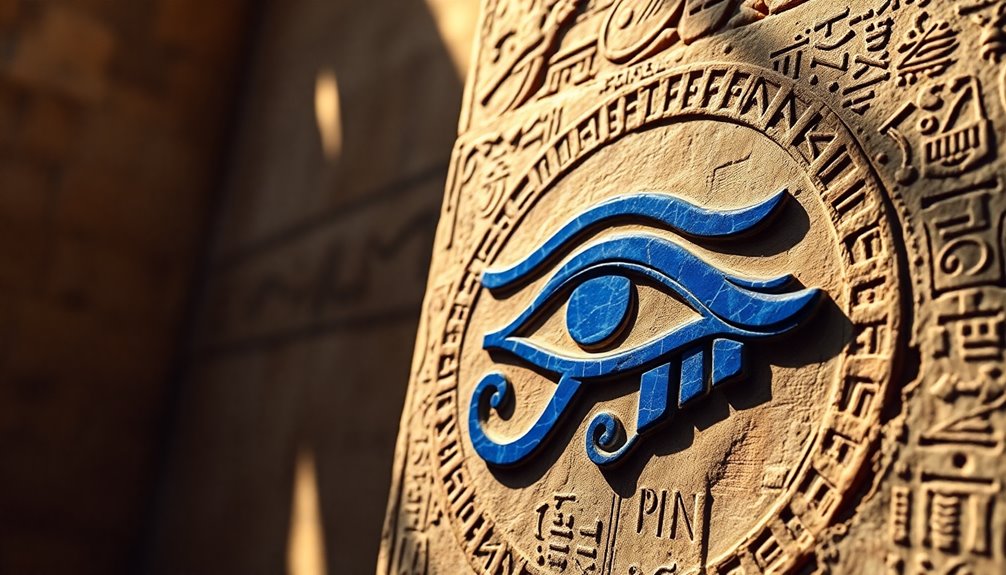
The Eye of Horus symbolizes protection and well-being, making it a powerful emblem in various cultures, particularly in the Middle East. In ancient Egyptian culture, this symbol represented good health, wisdom, and prosperity. Its roots lie deep in Egyptian mythology, where it embodies the duality of the sun and moon through the god Horus and his epic battle with Set.
You might find it intriguing that the Eye of Horus is divided into six parts, totaling 63/64, each corresponding to specific senses and mathematical fractions essential in ancient Egyptian commerce. This intricate design adds to its rich symbolism, emphasizing clarity and balance.
Today, the Eye of Horus remains a popular motif in modern practices. You'll often see it featured in amulets and jewelry, commonly gifted during significant life events like marriages or new home purchases.
This blend of ancient beliefs and contemporary applications showcases its enduring relevance. Additionally, the Eye of Horus appears in various forms of art, highlighting a cultural heritage that still enthralls scholars and enthusiasts alike. Its significance transcends time, enchanting you with its promise of protection and good health.
Connections to Neuroanatomy
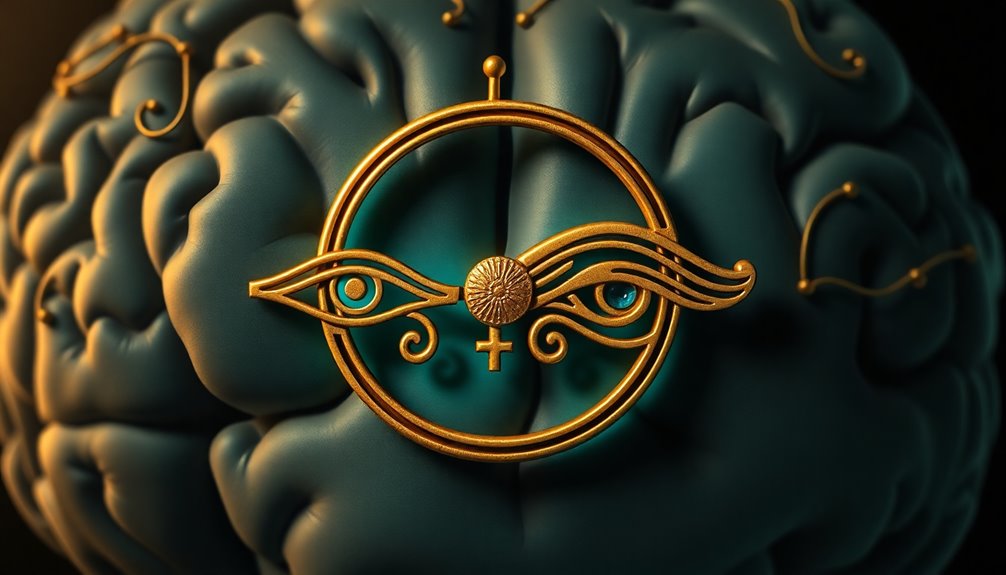
Exploring the connections between the Eye of Horus and neuroanatomy reveals fascinating insights into ancient Egyptian understanding of the human brain. The Eye of Horus, often dubbed the Eye of the Mind, showcases neuroanatomical links to major sensory centers.
For instance, the triangular section correlates with the olfactory trigone, illustrating its connection to the sense of smell. The pupil aligns with the interthalamic adhesion, which is essential for visual processing.
Moreover, the eyebrow shape corresponds to the corpus callosum, associated with thought and wisdom, highlighting a blend of ancient symbolism and cognitive function. The left triangular section of the Eye of Horus matches Brodmann areas 41 and 42, centers for hearing, showcasing the integration of sensory experiences in ancient Egyptian culture.
Additionally, the coil represents taste pathways, while the teardrop symbolizes somatosensory pathways, reflecting an extensive mapping of human sensory experiences.
This intricate web of connections not only underscores the Eye of Horus's role as a protective symbol but also exemplifies the advanced understanding of the brain's sensory architecture by the ancient Egyptians.
Mathematical Concepts in Ancient Egypt
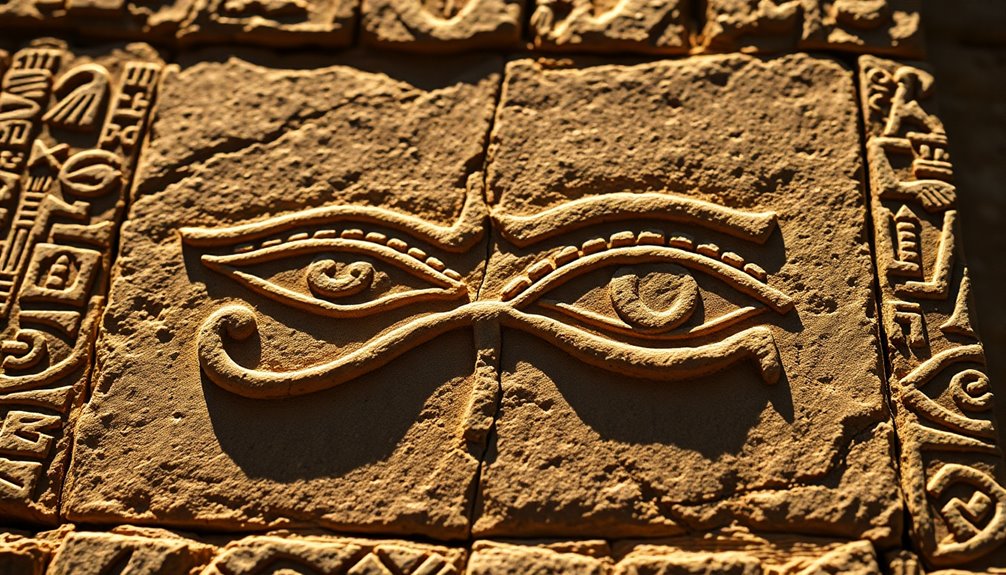
Mathematical concepts in ancient Egypt reveal a sophisticated understanding of numbers and geometry that underpinned their society. The Eye of Horus, beyond being a protective symbol, represented unique mathematical values, especially in fractions. This system was essential for daily life, especially in trade and resource allocation.
Consider these significant aspects of ancient Egyptian mathematics:
- Fractions: They used a fraction system that included values like 1/2, 1/4, and 1/8, critical for measuring grains and flour.
- Geometry: Their advanced knowledge of triangles facilitated the construction of awe-inspiring pyramids, showcasing innovation. Additionally, their understanding of geometric principles laid the groundwork for future architectural advancements.
- Problem-solving: Egyptian mathematicians applied practical techniques to tackle real-world challenges, such as land measurement.
The total value of the Eye of Horus, 63/64, symbolizes completeness and balance, emphasizing the importance of fractions in their trade and daily life. Additionally, the use of testing methodologies in their calculations reflects an early understanding of systematic approaches to problem-solving.
This integration of math and culture reflects how the Eye of Horus served not just as a mystical emblem but also as a functional tool for calculations. Understanding these concepts gives you insight into the remarkable achievements of ancient Egyptian civilization.
Key Symbols in Egyptian Mythology
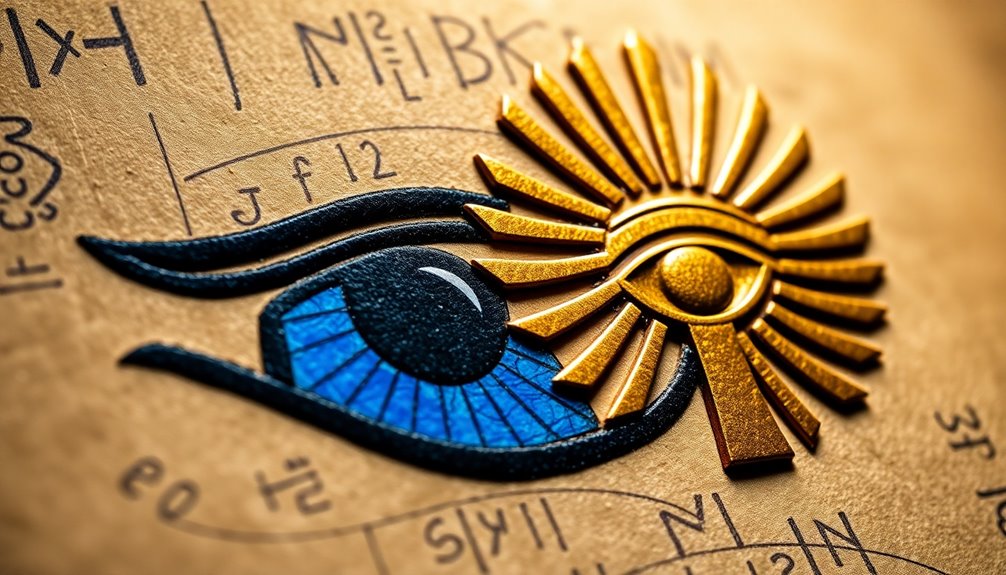
Ancient Egyptian mythology is rich with symbols that embody profound concepts and beliefs. Among these, the Eye of Horus stands out as a powerful ancient Egyptian symbol of protection, royal power, and healing. You'll often find it depicted in jewelry and amulets, serving as a safeguard against harm.
In contrast, the Eye of Ra represents the sun's fierce, destructive force and is personified as a goddess, linked to deities like Hathor and Sekhmet. This symbol emphasizes the duality of creation and destruction inherent in the mythos.
Another significant symbol is the Ankh, which signifies life and eternal existence. You might see it alongside gods and in funerary art, symbolizing a safe passage to the afterlife.
The Scarab Beetle also plays a vital role, representing rebirth and regeneration, and is commonly worn as an amulet for protection.
Lastly, the Djed Pillar symbolizes stability and endurance, associated with the god Osiris. It invokes cosmic stability and continuity, relevant in both life and the afterlife.
These symbols continue to resonate, influencing the modern world while connecting you to the ancient beliefs of gods and goddesses.
Eye of Horus vs. Eye of Ra
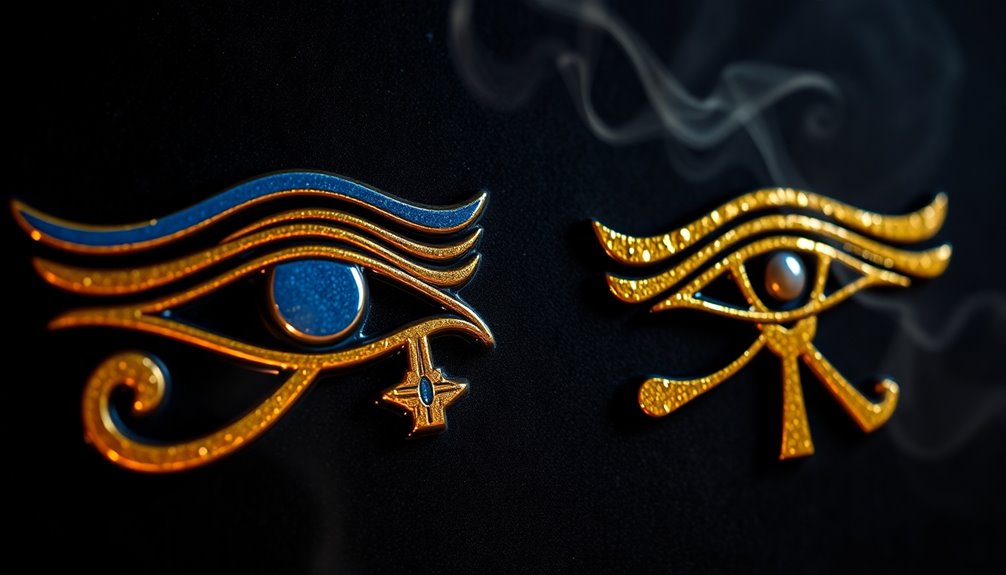
When you compare the Eye of Horus and the Eye of Ra, you'll notice they symbolize very different concepts.
The Eye of Horus, tied to protection and healing, contrasts sharply with the Eye of Ra, which embodies power and destruction.
Understanding their historical contexts can help you grasp how these symbols shaped ancient Egyptian beliefs and continue to resonate today.
Symbolic Meanings Comparison
Both the Eye of Horus and the Eye of Ra are powerful symbols in Egyptian mythology, but they convey different meanings. The Eye of Horus represents protection, healing, and royal power, reflecting a balance between life and death. On the other hand, the Eye of Ra embodies the destructive force of the sun, emphasizing the power and chaos that comes from divine judgment.
Here's a closer look at their symbolic meanings:
- Eye of Horus: This symbol is divided into six parts, totaling 63/64, linking to the senses and serving as a symbol of healing and restoration in ancient Egyptian culture.
- Eye of Ra: Often depicted as a fierce lioness, it illustrates the protective yet vengeful nature of the goddess Wadjet, punishing those who defy the divine.
- Duality of Protection: While both symbols offer protection, the Eye of Horus focuses on healing and restoration, whereas the Eye of Ra emphasizes the sun's might and the consequences of chaos.
In essence, these symbols show the complexity of ancient Egyptian beliefs, intertwining power with protection.
Historical Context Differences
While the symbolic meanings of the Eye of Horus and the Eye of Ra highlight their protective roles, their historical contexts reveal distinct narratives and functions within Egyptian mythology.
The Eye of Horus, or Wadjet, embodies protection, royal power, and healing, stemming from the myth of Horus losing his eye in the battle against Set. When Thoth restored it, the Eye became a symbol of wholeness and recovery.
In contrast, the Eye of Ra represents a more destructive force associated with chaos and punishment. This symbol connects to Ra's wrath, particularly through goddesses like Sekhmet and Hathor, who personify his vengeful aspects.
In addition to their different narratives, the physical representations of these symbols also set them apart.
The Eye of Horus, divided into six parts, highlights ancient Egyptian mathematical fractions, showcasing its connection to healing and protection in personal amulets and jewelry.
Meanwhile, the Eye of Ra primarily signifies divine retribution and strength, emphasizing its role in maintaining order against chaos.
Understanding these historical contexts enriches your appreciation of how each symbol functioned in the lives of ancient Egyptians.
Influence on Modern Culture
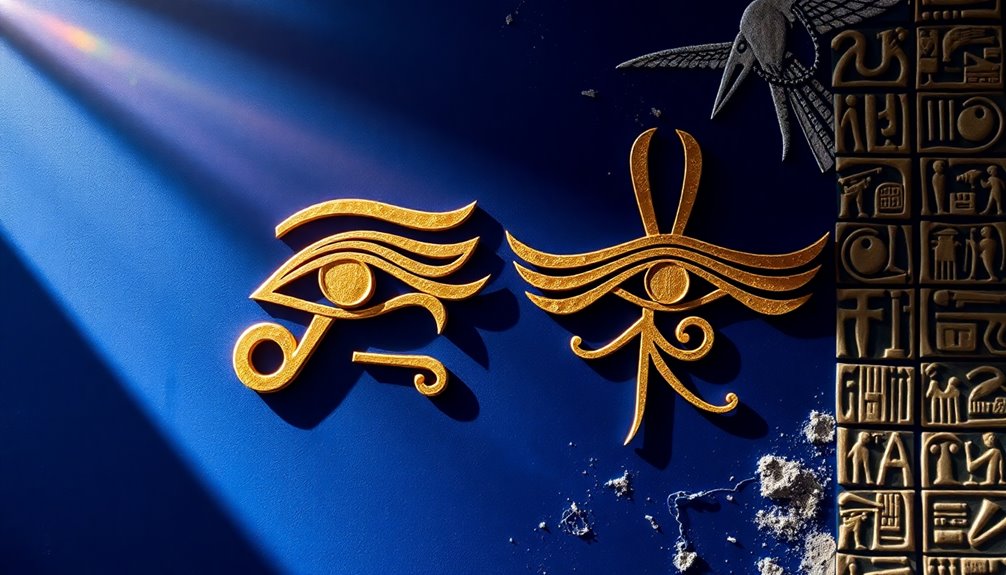
You might notice how the Eye of Horus and Eye of Ra have made a significant mark on contemporary art and fashion, appearing in everything from striking paintings to trendy jewelry.
In spiritual circles, these symbols often represent protection and enlightenment, reflecting their deep-rooted meanings.
As you explore social media, you'll find these ancient motifs are woven into modern narratives, showcasing their enduring appeal.
Contemporary Art Interpretations
The Eye of Horus and Eye of Ra have made a significant impact on contemporary art, serving as powerful symbols that resonate with themes of protection, power, and spirituality.
Artists today draw from these ancient symbols to comment on modern issues, creating works that blend historical significance with contemporary narratives.
Consider these vivid representations in contemporary art:
- Street Murals: Urban artists incorporate the Eye of Horus and Eye of Ra to address social injustices, using bold colors and striking imagery to capture attention.
- Graphic Novels: These symbols often appear as emblems of hidden knowledge, linking characters to secret societies like the Illuminati, deepening the narrative with layers of meaning.
- Tattoo Art: Many choose the Eye of Ra as a symbol of resilience, showcasing its power and spiritual significance on their skin for personal protection.
Through these modern interpretations, the Eye of Horus and Eye of Ra continue to inspire, reminding us of their enduring influence in today's culture.
Jewelry and Fashion Trends
Building on the contemporary art scene, jewelry and fashion trends have embraced the Eye of Horus and Eye of Ra as symbols of protection and spirituality.
You'll find these ancient Egyptian motifs woven into modern styles, creating a unique blend that appeals to both history enthusiasts and fashion lovers. The rise of sustainable fashion has encouraged designers to explore eco-friendly materials when creating pieces featuring these symbols.
The Eye of Horus is frequently incorporated into jewelry designs, often made from gold, silver, and gemstones.
These pieces serve not just as stylish accessories but also as protective amulets, believed to bring good luck to the wearer.
Tattoos featuring the Eye of Horus and Eye of Ra have surged in popularity, reflecting a modern aesthetic that values ancient symbolism for personal expression.
Contemporary designers are increasingly showcasing these symbols in their collections, with earrings, necklaces, and bracelets becoming popular gift choices for significant life events like weddings and graduations.
The transcendent nature of the Eye of Horus and Eye of Ra has influenced global fashion markets, inspiring countless designers to create pieces that celebrate ancient Egyptian art and spirituality.
In this way, these symbols continue to thrive in modern culture, bridging the past with the present. Additionally, much like the Indonesian decor masks, these jewelry pieces offer a rich cultural narrative that resonates with art lovers around the world.
Spiritual and Esoteric Practices
In various spiritual and esoteric practices today, the Eye of Horus and Eye of Ra serve as powerful symbols of protection and enlightenment.
These ancient Egyptian symbols resonate deeply within modern culture, reflecting a continued quest for divine oversight and safeguarding against negative energies.
You might be surprised to find how these symbols appear in different contexts, including:
- Freemasonry: Here, they symbolize enlightenment and a connection to higher knowledge.
- Modern Spirituality: Many use the Eye of Horus as a talisman for protection and healing, echoing its original purpose in ancient rituals.
- Art and Media: The Eye of Horus frequently graces contemporary art and jewelry, embodying themes of spirituality and the search for deeper meaning.
These symbols also intrigue popular culture, often linked to conspiracy theories like the Illuminati, which showcases their mystique.
Artistic Representations in Ancient Egypt
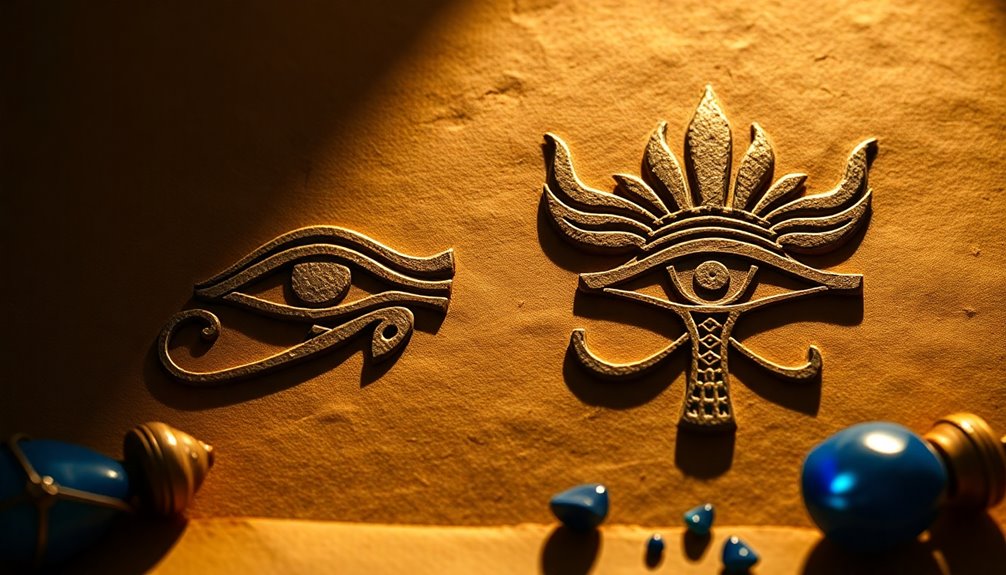
Ancient Egyptian art is rich with symbols, and two of the most prominent are the Eye of Horus and the Eye of Ra. You'll often find these artistic representations embedded in various forms, such as amulets, jewelry, and tomb paintings, each symbol conveying powerful messages of protection and divine authority.
The Eye of Horus, with its distinctive shape, carries dual significance; its right eye symbolizes power, while the left eye represents healing. This reflects the balance between strength and restoration in ancient Egyptian mythology.
In contrast, the Eye of Ra is frequently illustrated as a fierce, lion-headed goddess, embodying the sun's destructive force. You can see this representation in temple reliefs and hieroglyphs, highlighting its role in ancient Egyptian culture.
Artisans also integrated the Eye of Horus into architectural designs, using it to invoke protection for both structures and their inhabitants. Additionally, these symbols appear in detailed hieroglyphs on papyrus scrolls and stone inscriptions, emphasizing their importance in conveying messages of protection and royal power.
Together, the Eye of Horus and Eye of Ra serve as significant markers of ancient Egyptian symbolism.
Symbolism in Religion and Governance
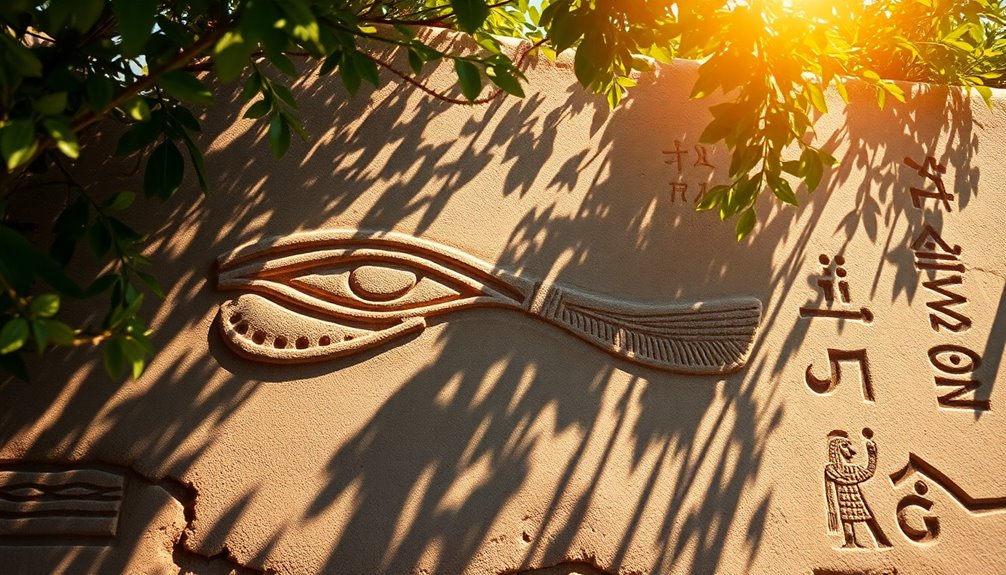
Symbolism plays an essential role in the intertwining of religion and governance in ancient Egypt, particularly through the Eye of Horus and the Eye of Ra. These symbols weren't just decorative; they were powerful representations of protection and divine authority, vital for the pharaohs who ruled with a mandate from the gods.
Consider these vivid images:
- The Eye of Horus, a protective amulet, safeguarding the state and its citizens from chaos.
- The Eye of Ra, reflecting the sun god's watchful gaze, ensuring balance in governance.
- Hieroglyphics featuring these symbols carved into tombs, linking divine protection to pharaonic authority.
In religious practices, the Eye of Ra reinforced the pharaohs' divine right to rule, while the Eye of Horus became synonymous with royal power.
These multifaceted symbols transcended mere imagery, embedding themselves in the political and spiritual narratives of ancient Egyptian civilization. By invoking these symbols, the pharaohs not only asserted their governance but also connected their rule to a greater cosmic order, ensuring the safety and prosperity of their domain.
Ongoing Mysteries and Interpretations
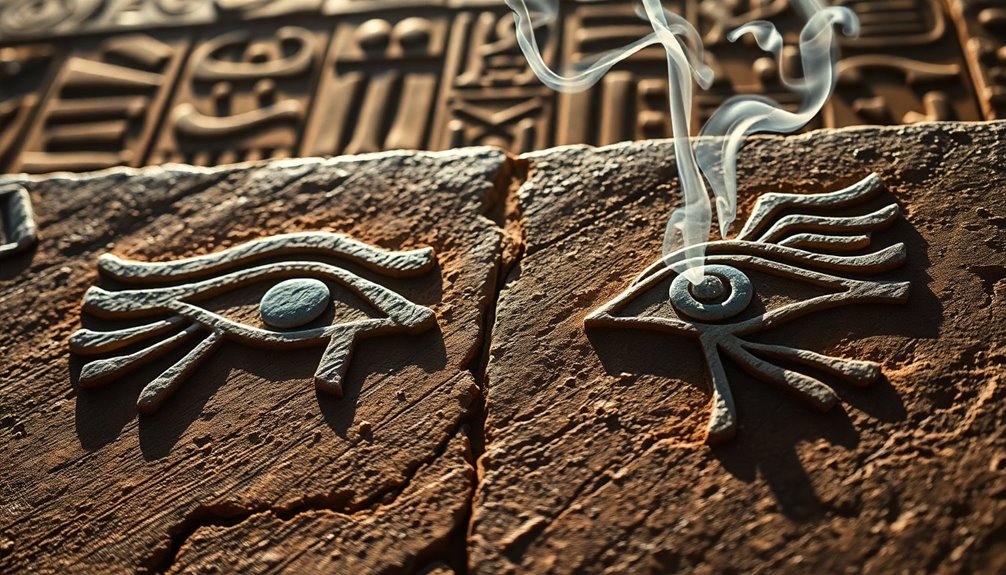
The Eye of Horus and Eye of Ra continue to evoke intrigue, fueling ongoing debates among scholars and enthusiasts alike. Each symbol carries rich meanings rooted in ancient Egyptian mythology.
The Eye of Horus, or "Wadjet," stands for protection and healing, embodying restoration after Horus's eye was lost in battle. In contrast, the Eye of Ra signifies the sun god's destructive power and divine retribution, often linked to the punishment of humanity for disrespecting the gods.
The duality of these symbols reflects a balance between order and chaos. While interpretations of the Eye of Horus highlight its role in safeguarding and healing, the Eye of Ra's fierce guardianship can be seen as a warning against imbalance.
Scholars still debate their origins and meanings, adding layers of complexity to their symbolism. The Eye of Horus is intricately divided into six parts, each representing a fraction in ancient Egyptian mathematics, while the Eye of Ra's interpretations have evolved through associations with goddesses like Hathor and Sekhmet.
Modern interpretations have expanded these ancient meanings, with the Eye of Horus symbolizing spirituality, while the Eye of Ra often resonates with themes of power and dominance.
Frequently Asked Questions
What Is the Negative Meaning of the Eye of Horus?
The Eye of Horus can symbolize negativity when misused or misunderstood.
You might see it as a representation of potential harm or vengeance, especially if wielded by those with ill intentions. Its association with power can also evoke notions of oppression.
Additionally, the missing piece of the Eye signifies imperfection and chaos, highlighting the struggle between order and disorder, which can be unsettling.
Ultimately, it can remind you of mortality and the unknown.
What Is the Secret of the Eye of Horus?
The secret of the Eye of Horus lies in its deep symbolism of protection, healing, and royal power.
When you explore its six parts, you'll find they represent the senses, showcasing its connection to human experience.
The myth of Horus losing and regaining his eye reflects the themes of struggle and restoration.
Is the Eye of Horus Good or Bad?
You might wonder if the Eye of Horus is good or bad.
As you explore its meaning, you'll discover it's mainly seen as a protective symbol, shielding you from misfortune and chaos. This ancient emblem signifies health and royal power, fostering a sense of security.
While it has dual aspects, its primary essence leans toward benevolence.
Is It Okay to Wear the Eye of Horus?
Yes, it's generally okay to wear the Eye of Horus. Many people see it as a symbol of protection and good fortune, connecting to ancient Egyptian traditions.
When you choose to wear it, you're honoring its history and meanings, which can be quite empowering.
Just be mindful of cultural sensitivities and respect its origins.
Ultimately, if it resonates with you and brings you positive energy, then go ahead and wear it proudly!
Conclusion
As you explore the Eye of Horus and the Eye of Ra, you can't help but wonder: could these symbols hold deeper meanings tied to our neuroanatomy? Some theorists suggest they mirror our brain's structure, hinting at a profound understanding of human consciousness by the ancients. While interpretations vary, the enduring allure of these symbols invites you to question their true significance. What hidden truths might they reveal about our own minds and cultures today?

